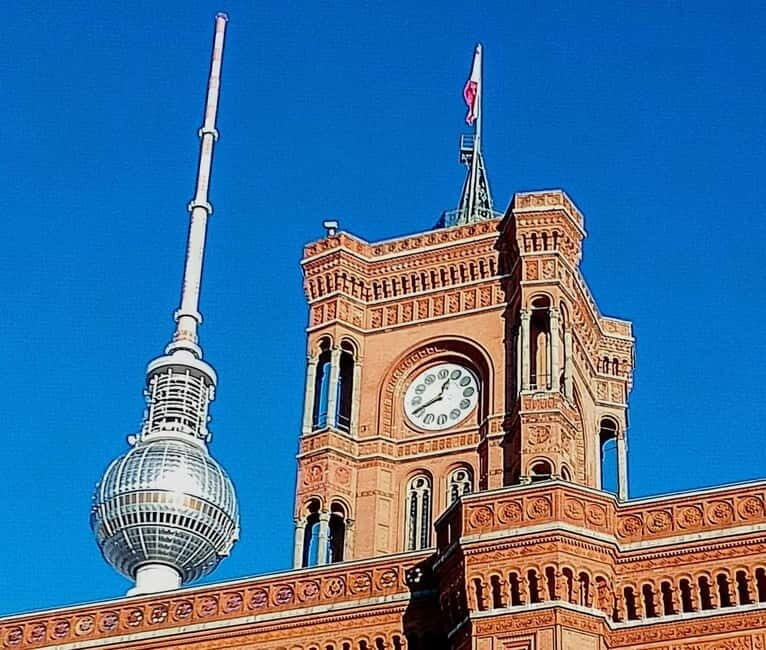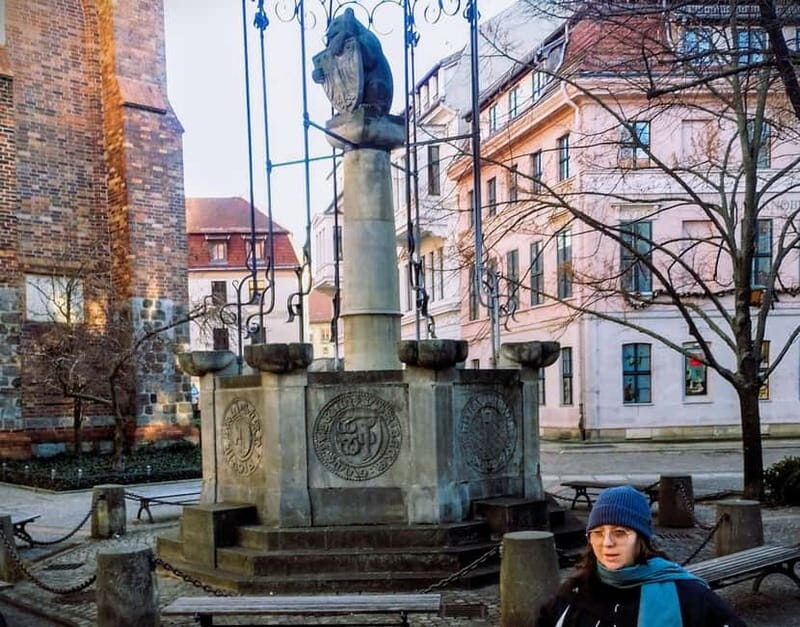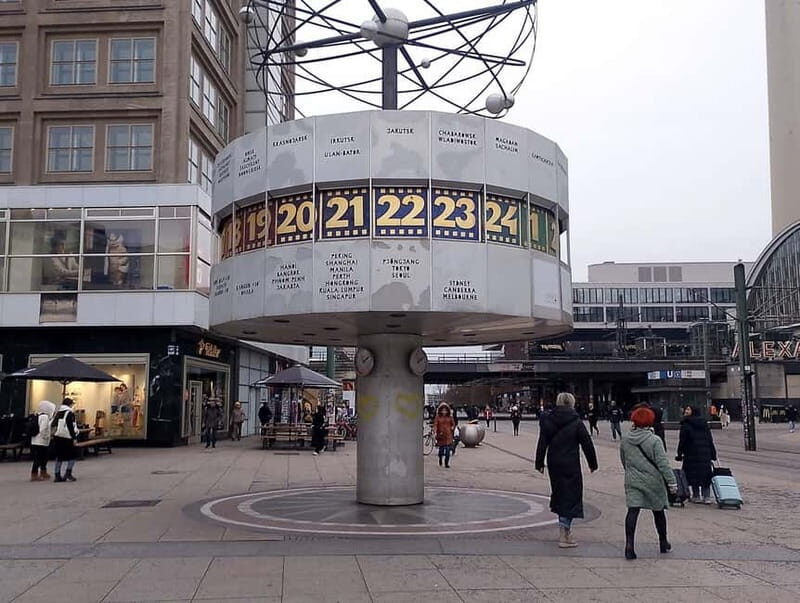Berlin: World Clock to World Heritage & World War 2 Walk is a lively, compact tour that packs in over 800 years of Berlin’s history into just 90 minutes. Starting at the iconic World Clock in Alexanderplatz, this walk takes you through the city’s main sites, revealing how Berlin’s past has shaped its present. Guided by a knowledgeable local, you’ll see landmarks like the Berlin TV Tower, Nikolaiviertel, Berlin Cathedral, and Museum Island, finishing at the Humboldt Forum in the reconstructed Royal City Palace.
What we particularly love about this experience is how it combines iconic sights with deep historical insights. The guide’s storytelling makes the city’s layered history accessible and engaging, especially when explaining how WW2 bombs altered Berlin’s architecture. Plus, the inclusion of a free made-in-Berlin souvenir adds a charming personal touch. A slight drawback might be that the walk doesn’t include the Brandenburg Gate or Reichstag, but for those interested in a well-rounded overview, it’s easy to complement this with other tours or visits.
This tour suits first-time visitors who want a quick yet meaningful overview of Berlin’s evolution, especially those who enjoy learning about architecture styles spanning Baroque to Brutalism. It’s perfect for families, solo travellers, and groups, even pet owners, thanks to its accessibility and relaxed pace.
Key Points

- Concise yet comprehensive: Covers most main attractions within 90 minutes.
- Historical depth: Explains the impact of WW2 bombs on Berlin’s architecture and layout.
- Visual storytelling: Offers insights into Berlin’s development from 1900, 1945, and 1990.
- Authentic local insights: Led by a guide with personal experience and academic background.
- Family-friendly: Suitable for kids, adults, groups, and pets.
- Value-added extras: Includes free souvenirs, water, and helpful gear like umbrellas and gloves.
A Detailed Review of the Berlin: World Clock to World Heritage & World War 2 Walk

If you're drawn to exploring Berlin on foot, we've looked into these other walking experiences
Starting Point and First Impressions
The tour kicks off at Alexanderplatz, one of Berlin’s most recognizable squares, dominated by the World Clock. This spot isn’t just a meeting point; it’s a symbol of Berlin’s modern identity, connecting time with the city’s layered past. Our guide, wearing a red cap with a Berlin Bear patch, immediately sets an approachable tone, making it easy for everyone to feel included.
The walk is designed to be accessible, covering about 1.4 km (less than a mile), perfect for those who want a quick but thorough introduction. The small group size ensures personal attention and lively conversation.
Exploring the Main Sights
Alexanderplatz & the World Clock
Here, we get a quick overview of Berlin’s transformation from a medieval trading hub to a 20th-century metropolis. The World Clock itself is a photo magnet—an ideal spot for snapping that first Berlin shot.
Berlin TV Tower
Next, we make a short stop at the Berlin TV Tower for a photo and a quick overview. It’s one of the tallest structures in Europe and a symbol of East Berlin’s modernist ambitions. The guide explains its history and significance, helping us appreciate its place in Berlin’s skyline.
Rotes Rathaus (Red Town Hall)
A quick photo stop here introduces you to Berlin’s administrative heart. The Rotes Rathaus is a striking example of neo-Renaissance architecture, contrasting with the surrounding modern buildings.
Nikolaiviertel & River Spree
Strolling through Nikolaiviertel, Berlin’s oldest residential quarter, we absorb the charm of medieval streets and learn about its reconstruction after WWII. Passing the River Spree, the guide highlights how the city’s waterways have shaped its development.
Berlin Cathedral & Museum Island
The highlight for many is the Berlin Cathedral, with its impressive dome. From here, we explore Museum Island, a UNESCO World Heritage Site, with its collection of historic museums and stunning architecture. The guide enriches our visit with stories about how WW2 bombs devastated parts of the city, and how reconstruction efforts have resulted in a mix of Baroque, Bauhaus, and Brutalist structures.
Humboldt Forum & Royal City Palace
The tour culminates at the Humboldt Forum, a recent and somewhat controversial reconstruction of the Royal City Palace. This spot encapsulates Berlin’s ongoing dialogue between past and present. The guide provides context about the building’s history, its destruction, and its modern rebirth, giving us a tangible sense of how Berlin continues to redefine itself.
Insights on Berlin’s Architecture and History
One of the most compelling aspects of this walk is how it explains Berlin’s architectural layering. The guide points out how the city’s image was altered by WW2 bombs, which created a patchwork of different styles—Baroque, Bauhaus, and Brutalism. You’ll learn that the city rebuilds itself not just physically but also culturally, reflecting its complex history of destruction and renewal.
The impact of WW2 is made clear through stories about bomb damage and the layered cityscape, which includes both historic and modern buildings. The tour effectively demonstrates how Berlin’s scars are woven into its architecture, making the city a living museum.
More Great Tours NearbyThe Guide and Experience Quality
Our guide, a Berliner raised in a family with roots in both Berlin and Hamburg, is well-versed in history and politics. His background as a journalist and exhibition designer adds depth to his storytelling, making complex history engaging and understandable. His personal insights help illuminate Berlin’s evolution from 1900 to the present day.
Helpful extras like umbrellas, gloves, and hats are provided free, which is a thoughtful touch—especially in unpredictable weather. The tour is wheelchair accessible, although it’s worth noting that it doesn’t include the Reichstag or Brandenburg Gate.
Interested in history? Here are other past-focused experiences we've examined in Berlin
Value for Money
For around €20-€30 per person, this tour offers a lot of insight for the price. It’s a perfect addition if you’re short on time but want to see the key sights with a meaningful narrative. The inclusion of a free souvenir and recommendations for further activities adds extra value, making it a practical choice for planning your stay.
Who Should Consider This Tour?
This walk is ideal for history buffs, first-time visitors, and anyone interested in understanding Berlin’s layered architecture and wartime scars. It’s suitable for families, solo travelers, and groups, even those traveling with pets. If you prefer a more comprehensive look at Reichstag or Brandenburg Gate, you might want to pair this with other tours.
Final Thoughts
This tour offers a balanced look at Berlin’s past and present, blending sightseeing with storytelling. It’s not a deep dive into every aspect of Berlin’s history, but it’s a well-paced primer that leaves you with a good foundation. The guides’ local knowledge and engaging style make it both educational and fun.
Overall, it’s a smart choice for travelers who want a timely, manageable, yet meaningful introduction to Berlin’s history, architecture, and wartime scars—delivered in a friendly, approachable way.
FAQ

Is this tour suitable for children?
Yes, it’s suitable for families and groups, and even pet-friendly, making it a flexible option for travelers with kids or pets.
How long does the walk last?
The walk lasts approximately 90 minutes and covers about 1.4 km.
Are food and entrance fees included?
No, entrance fees to attractions are not included, and food is not provided. It’s a sightseeing walk rather than a museum or attraction visit.
What should I bring?
Comfortable shoes, a hat, an umbrella, water, and gloves are recommended, especially in variable weather.
Does the tour include the Brandenburg Gate or Reichstag?
No, this particular walk does not stop at those sites, but the guide suggests other tours that do.
Is the tour accessible for people with mobility impairments?
It’s wheelchair accessible, but some aspects might be limited, and the walkthroughs are on paved surfaces.
Can I cancel the tour?
Yes, you can cancel up to 24 hours in advance for a full refund.
How do I find the meeting point?
The meeting point is at the World Time Clock next to the Alexanderplatz Metro station—look for the guide in a red cap with a Berlin Bear patch.
This guided walk offers a balanced, insightful, and manageable way to discover Berlin’s historical layers. Whether it’s your first visit or a quick refresher, you’ll gain a broader understanding of how this city’s past continues to shape its streets today.
You can check availability for your dates here:More Historical Tours in Berlin
- Berlin: Historical Tour along the Death March Path with Car
- Berlin: 3-Hour World Heritage Cruise to Potsdam
- 2-H Fabulous Berlin Historical Guided Fat Tire Tour
- Berlin: Historic Guided Walking Tour with Museum Island Pass
- Berlin Rickshaw Tours Historical & Photo City Tour 120min – Sightseeing
- Berlin Beers & Battlefields Tour: War History and German Beer
More Walking Tours in Berlin
More Tour Reviews in Berlin
More Berlin experiences we've covered
- Berlin: World Clock to World Heritage & World War 2 Walk
- Berlin: Cold War Walking Private Tour with Guide
- Berlin: East Side Gallery and Cold War Segway Tour
- Berlin: BRLO BRWHOUSE Tour and Craft Beer Tasting
- Berlin: Gay Berlin Out in Schöneberg Walking Tour
- Berlin: Create Your Own Spin Painting at Jans Echternacht
- Berlin: 1-Hour Reichstag Tour
- Berlin: Wintergarten Varieté theater tour
- Berlin: Reichstag, Dome and Government District Guided Tour
- Berlin: Pub Crawl & Party with Free Shots & VIP Club Access
- Berlin: Decolonial Sightseeing Walking Tour with BIPOC Guide
- Berlin: Reichstag, Plenary Chamber, Cupola & Government Tour
